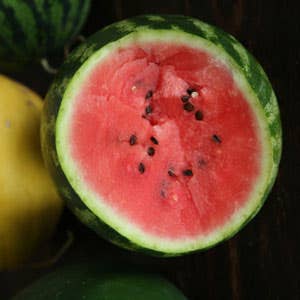
Varieties of Watermelon
In this country, hundreds of watermelon cultivars have been developed by farmers and horticulturists over the years; they vary widely in taste, texture, and color. Here are 18 of our favorites.
Check out our favorite watermelon recipes »
Yellow Doll
Weighing no more than eight pounds, this extra-sweet, golden-fleshed mini has especially soft fruit, which makes it an excellent ingredient for smoothies and iced cocktails.
Crimson Sweet
The amply proportioned crimson sweet is famous for its sugary, bright red flesh; it is a cross of the charleston gray, miles, and peacock varieties and has a honeyed taste that pleasantly offsets feta and mint.
Extazy
The pint-size extazy is a seedless melon that averages five pounds and is grown mostly in California and Arizona.
Golden Midget
The rind of the stunning golden midget, a mini weighing only three pounds, turns yellow when ripe. Elwyn Meader and Albert Yeager, well-known breeders at the University of New Hampshire, developed the variety in 1959.
Jubilee
Developed in 1963, this popular, supersweet cultivar may weigh up to 45 pounds, so it ranks as a giant, a classification conferred on watermelons exceeding 32 pounds at full ripeness.
Mickylee
A lovely, speckled rind and dense red flesh characterize this 22-year-old seedless variety, which averages 12 pounds.
Moon and Stars
Studded with a constellation of lemon-colored dots, this heirloom variety, which can weigh as much as 40 pounds, nearly disappeared only a few years after it was introduced, in the 1920s, but has recently made a comeback.
Pixie
This miniature, seedless melon averages only six pounds and has thick stripes along its rind; the succulent pixie is part of a breeding trend that favors very sweet, seedless fruit.
Cream of Saskatchewan
This rare, creamy-fleshed melon usually weighs about ten pounds. The cultivar is said to have been brought to North America by Russian immigrants who settled in the Canadian province of Saskatchewan.
Sangria
Developed in 1985, this supersize variety is beloved for its scarlet-colored, nonfibrous flesh. The melon’s popularity has diminished recently owing to a demand for smaller varieties.
Starbrite
The bright pink, medium-firm flesh of this variety, a descendant of the charleston gray and the crimson sweet, is perfect for pureeing into granitas or sorbets.
Starlight
The pristine, amaranth-colored fruit of this mini cultivar glistens with juice. It’s easily transportable¿and deeply satisfying.
Stars 'n' Stripes
This hybrid, named for the green stripes streaking across its rind, has an elongated shape and can weigh as much as 30 pounds; it is well loved for its firm, sweet, deeply colored flesh.
Sugar Baby watermelon
The comparatively small (nine to 13 pounds) sugar baby is often referred to as an icebox watermelon. Developed in 1955, it has soft, sweet fruit and a dark green rind.
Summer Flavor
Numerous subcultivars of this popular variety now exist. Summer flavor #420, pictured, is a cross between a crimson sweet and an allsweet.
Sweet Favorite
Dappled with light green patches on a blue-green rind, the sweet favorite has juicy, ruby-colored fruit that’s well suited to relishes and chutneys.
Keep Reading
Continue to Next Story










